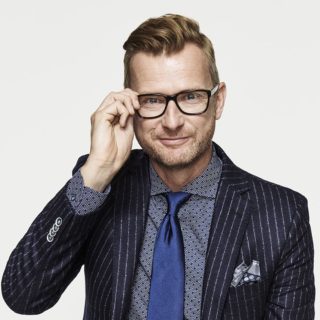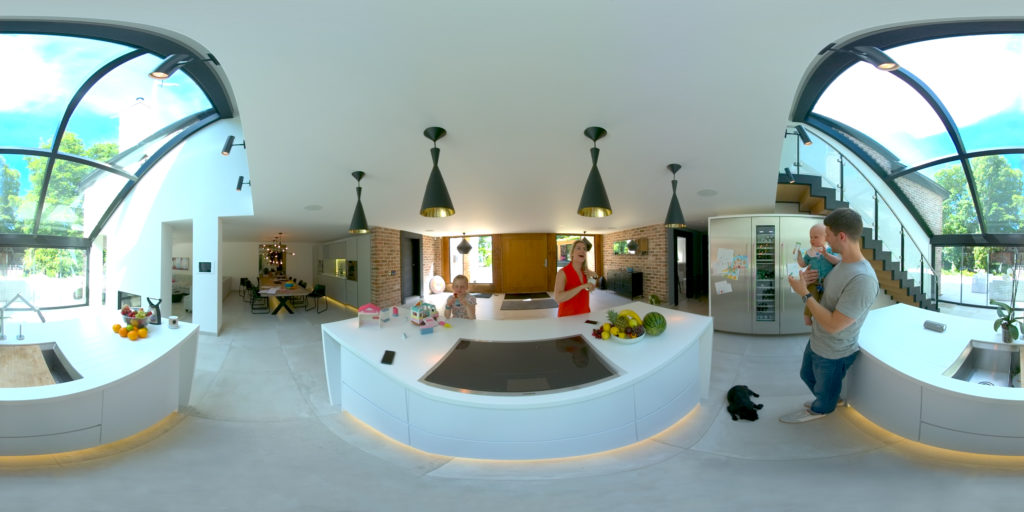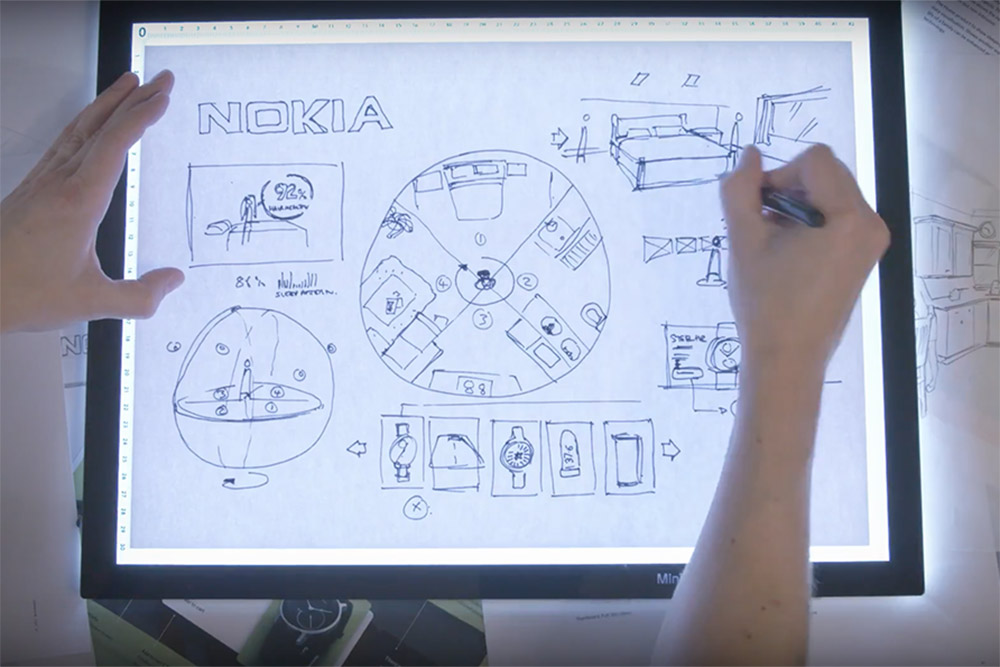If there was ever an event for a marketer to announce a rebrand with a futuristic campaign and messaging, the Cannes Lions International Festival of Creativity has to be on the short list.
Nokia Technologies is throwing its name in the imaginative and artistic hat for showing off all things cool at the week-long, French Riviera-based fest by demonstrating the future of virtual reality advertising and e-commerce with its own digital health VR spot “Healthier Together.”
The VR campaign premiered Monday and is designed to immerse viewers into the home environment and have them experience its soon-to-be-launched portfolio of digital health products along with the family. It’s described as “an evolution of digital advertising allowing consumers to discover, interact with and make purchases within a VR experience with the first industry e-commerce component.”
Following the $190 million acquisition of health gadget maker Withings last May, “Healthier Together” is part of a new strategy for Nokia Technologies to rebrand its digital health products.
The Cannes-launched campaign was created using the Nokia’s OZO+ camera and software—a $40,000 VR rig that’s making brands and professional creators rethink storytelling. The spot includes Nokia-branded smart watches, connected scales, blood pressure monitors and other consumer-focused health devices.
Rob Le Bras-Brown, chief marketing officer at Nokia Technologies, joined AListDaily for an extensive interview to talk about how they plan on leveraging VR as a company.
Why was the Cannes Lions International Festival of Creativity the ideal place to reveal this activation?
Cannes Lions unites communities in marketing, entertainment, communications, design and tech talent from across the world. VR cuts across, and is exciting to all of those disciplines. So in that regard, it was a natural place to launch this initiative. Moreover, Cannes Lions has set aside an entire track around healthcare communications and tech. “Healthier Together” is our campaign to support the launch of the new Nokia digital health products where we’re using our own OZO VR technology to show people how easy it is to use these products in a real home, with a real family. Cannes Lions offered not only a great programmatic fit, but also a great place to highlight to some of the most creative minds in the industry how VR can enhance a brand strategy.
What are the trends and strategies that you’ll be monitoring at Cannes Lions International Festival of Creativity?
We’ll be focused on how companies are embracing and incorporating VR into their branding and marketing efforts, which is exciting and inspiring for us. We’ll also be playing close attention to new introductions and innovations in digital health. At a higher, strategic level, we’ll be looking out across the range of technologies and discussions with an eye toward trends that relate to connectivity, which is, of course, at the core of the Nokia brand and our product offerings.

Why is Nokia positioning the brand with new digital health products and solutions? What went into the rebrand of this specific portfolio?
The Nokia brand enjoys over 95 percent global awareness and is universally synonymous with trust, reliability and quality. So these new digital health products are a natural fit for the brand, and the overall Nokia portfolio. If you look back at Nokia’s business, we’ve been about helping people connect and we continue today to create the technology that connects the world. Whether it’s our phones, our network business, or VR, we connect the world. Our digital health portfolio is built around that same premise. Our wearables, the Healthmate App or the other products in the lineup, connect seamlessly together, providing actionable insights and helping families and friends be healthier together. The rebrand is one more step toward Nokia’s goal to help bring the human family closer together.
How is discovering and interacting with and making purchases within a VR experience the next frontier for brands?
Because it’s inevitable. Over time, messaging and commerce always converge in the channels available to marketers—look at social media as a recent example. VR will be no different. I believe we’ll see increasing initial forays into providing a purchase experience within VR in the relative near term, but there will be other experiments as well—and that excites me. Marketers are just now starting to discover and explore the potential for VR in advertising and branding. I think the most crucial piece in the immediate future is for CMOs to get curious, to get their arms around what VR can offer them. Whenever a new technology comes around, the calling for a CMO should be to ask “how can that technology support and complement their brand?” After a time, there will come the realization that sound branding principles always apply and the focus shifts to using whatever the new technology is to build on magnifying the impact of those principles. For example, we know that strong brand creative is a precursor to strong emotional connection between the brand and the consumer. Brand equity and loyalty are created through affinities that arise from shared values, common experiences and a host of other intangible and emotional connections we have with the brands that resonate with us. VR is, at its core, the ultimate connective, immersive technology. I believe that CMOs will quickly find ways to use VR to deepen the emotional connection with their consumers by creating content that enables them to not just “watch” the brand, but also “experience” it. I think you’ll see that type of content emerge next, with exploration into driving purchase following closely behind as we have a better understanding of what experiences consumers will find most engaging.
How do you envision VR advertising developing in the future?
To date, efforts to market and reinforce brand values using VR have fallen broadly into three categories. One is brand leadership through association with and use of futuristic technology. Two is promotion and exploration of specific products through hands-on interaction and virtual tours. Three is augmentation of and further immersion into an existing brand identity by creating content that allows consumers to experience the brand and its values, rather than just illustrating them. The results have yielded immersive experiences ranging from Louis Vuitton putting viewers in the middle of Fashion Week in Paris, to Red Bull strapping viewers to the wing of an acrobatic barnstormer, to Hyundai enabling service members to view the Super Bowl “with” friends and family. Over the course of the next year, I think the industry will see a dramatic expansion and experimentation in how VR is used in advertising. There will always be a place for VR to deliver a particular product to consumers in a new and different way, but the real revolution will come in how VR is used to create experiences that deepen consumer connection to brands. Moreover, as we start to build these experiences, because of the enormous analytical capabilities of VR, we will be able to gain an understanding of which elements consumers find most engaging, and which elements they wish to interact with. As we better understand these, and other factors, marketers will be able to surgically tune and personalize content that highlights brand values while allowing consumers to immerse and move through experiences that are inherently interesting to them.

Do you believe VR has a viable e-commerce component? How else can you explore this area in the future?
It absolutely does. With the launch of our “Healthier Together” VR spot, we’re showing what’s possible today, and I believe that VR will quickly provide a viable e-commerce component that brands will turn to and explore. VR allows for previously unimagined and unique ways to help consumers discover, compare and move to purchases. To date, a consumer has had to disengage to complete a transaction. Now we’re on the eve of transactions within the experience itself.
Now that the Nokia OZO has been on the market since November 2015, what are the insights and data that you can share about the camera? What are the marketing successes and challenges that you’ve experienced?
While we announced the camera in November 2015, the product actually came to market in Q1 2016. It simply amazes me how in just over 12 months, the camera, and now the software, have become a mainstay for professional content creators. In particular, OZO has become the “go to” for multi-camera livestreaming, from Coachella, to UEFA, to product launches and especially mission-critical projects like Obama’s farewell speech, or Hyundai’s Super Bowl spot. The volume, breadth and quality of recorded content that has been created with OZO is a testament to its success. OZO has been used to create myriad content ranging from music videos, short stories, education, documentaries and behind the scenes footage, including the Star Wars franchise. I love it when we’re introduced to a new VR piece that was made with OZO and we had no idea it was coming. It’s gratifying and delightful to see the market appreciate and maximize the potential of the OZO products and this is the reward that the Nokia team in the Bay Area and Finland like the most. Like all new technologies, the tipping point and velocity of adoption are challenging to predict and these elements will be what ultimately dictates the potential for VR in the next few years. It’s great to see head-mounted displays (HMD) starting to take traction in the mainstream—growth here will be critical to encouraging the continued production of content. But there is of course a chicken-and-egg tension—our industry needs to create compelling content to drive interest and engagement in the medium; this will help fuel HMD sales. This is not a challenge unique to OZO—it’s a challenge for the VR industry. Collectively, we need to accelerate populating both sides of the ecosystem to generate maintain consumer enthusiasm and momentum. For our part, at Nokia, we keep pushing the technology envelope. At NAB this April, we announced OZO Reality, our vision for virtual and mixed reality and introduced solutions that work seamlessly across the three critical elements of production—create, deliver and experience. For creators, we announced the new OZO+ camera, the next generation of our award-winning camera that advanced image quality dramatically and works alongside the new OZO Creator with depth mapping. But great content needs to get delivered to as many eyeballs as possible and for this, we announced OZO Deliver, a view-dependent, rendering technology that enables content to be streamed much more efficiently over existing networks. Finally, the content needs to be experienced as the creator intended—for which we offer OZO Player SDK, and OZO Audio. This continuum of products works perfectly together with our partners’ products along with the full production path offering capabilities that I believe brand managers and advertisers should find incredibly exciting.
Where does VR stand in Nokia’s overall marketing strategy? How are you planning for further growth in the vertical?
VR is a stand-alone business unit within Nokia Technologies and we’re investing significantly in developing industry-leading capabilities and IP—both in hardware and software—targeted to the professional community. We like to say that “there’s VR, and then there’s OZO Reality.” Our vision for OZO is extremely exciting and we’ll continue to innovate and offer advancements to the marketplace. What is critical to our success is our continued partnership with creators and producers, who give us direct, candid, insightful feedback about what they love, what they want improved and what they want next. This direct customer feedback and input helps us focus on what matters to this nascent industry. Recently, we haven’t just been marketing our VR products—we’ve been using them, too. I’m very proud of the fact that for the launch of our new digital health products, our VR agency partner Brandwidth embraced the OZO+ camera and OZO software products to create our “Healthier Together” VR ad. I believe Nokia has a responsibility to experiment and lead the way with VR.
Which Nokia product are you most excited about this year? Why? Do you see any challenges with how the market will respond to it? Are there any exclusive plans—like influencers, paid social, content marketing—on how you’ll be reaching the right audiences for the product?
I’m excited about the new Nokia digital health lineup. At launch, we’ll offer the world’s broadest range of consumer digital health products that work seamlessly with one app, Nokia Health Mate. We’ve been working on this for a year, so it’s a big deal for us to finally see our baby get to the marketplace; we’re delighted with the response of our retail partners. What really motivates me, though, is that these aren’t just gadgets—they’re beautifully designed and engineered connected devices that inspire the individual to take control of their own health, and in doing so, we have the potential to positively affect the wellbeing of society as a whole. We believe in the possibility that the human family can live healthier together, and I can tell you that gets me and the team at Nokia out of bed every day with a bounce in our step. Within our VR offerings, OZO+ is one of my favorites but I think OZO Deliver is a very powerful product and an exciting enabler for VR on existing networks. Creating wonderful VR content doesn’t benefit anyone if it can’t be efficiently delivered to the consumer. By their nature, VR files are really large. VR cameras generate a lot of data and moving that data over a network to a display screen requires a lot of bandwidth. Fortunately, Nokia knows a thing or two about connecting people, and we’re driven to create the technology that connects the world. Part of our marketing program is to partner with customers on exciting new content. There will be a paid media campaign and we will continue to offer customer testimonial content and work with influencers who are credible and accretive to our brand. We’re continually exploring new partnerships for content of all types, including entertainment, advertising, training—but also the unexpected. We just partnered with a hospital in Helsinki for the first ever neurosurgery in mixed reality. The hospital livestreamed a real operation on a brain to over 200 remote surgeons and layered in computer graphics to aid in the explanation and learning of the procedure.
How are you using social data to better connect with consumers?
Like any brand, we strive to engage with our fans and customers where they are and importantly—where they want to be. It’s our privilege to be a part of this conversation and we know that we have to earn the right to be invited in and engaged with. Therefore, we’re conscious of the need to add value to the conversation. In our digital health business, we have massive amounts of data that we’re able to anonymize, aggregate and synthesize into fascinating and compelling insights. In VR, the promise for marketers and brand owners is that they can finally find the holy grail of understanding exactly what their customer is looking at and engaging with. They could literally know what their fans are looking at, or not looking at. This can finally allow brand marketers to curate and design their content with the precision they’ve dreamt about.
How do you plan on evolving the overall Nokia narrative through marketing for the rest of this year? What kind of digital and social messaging can we expect?
You can expect to see social messaging that builds on these platforms and works through the customer journey, from discovery, right down to the last three feet and clicks. The narrative at Nokia is crisp and aligned—so our focus now is all about activating it. At Nokia, we create the technology that connects the world and in so doing, enable the human possibilities of technology in a connected world. This is the perfect complement to our mission at Nokia, where we’re focused on designing technology that brings the human family closer together. Our new Nokia health products are a perfect example of this vision coming to the market. Complementing that is our continued innovation in VR and the extensive library of content that has been created with OZO that helps the human family “feel together.”
Follow Manouk Akopyan on Twitter @Manouk_Akopyan

